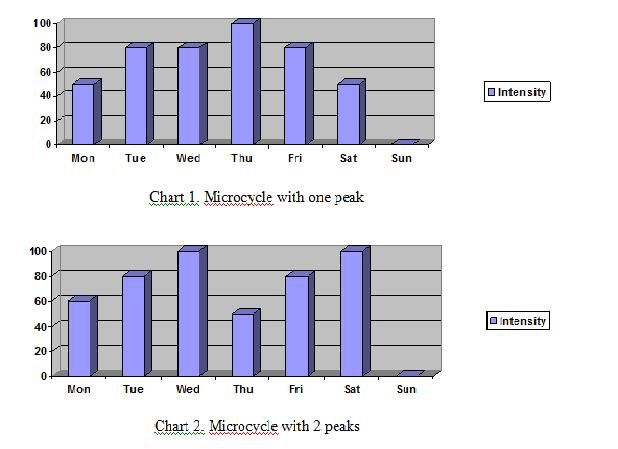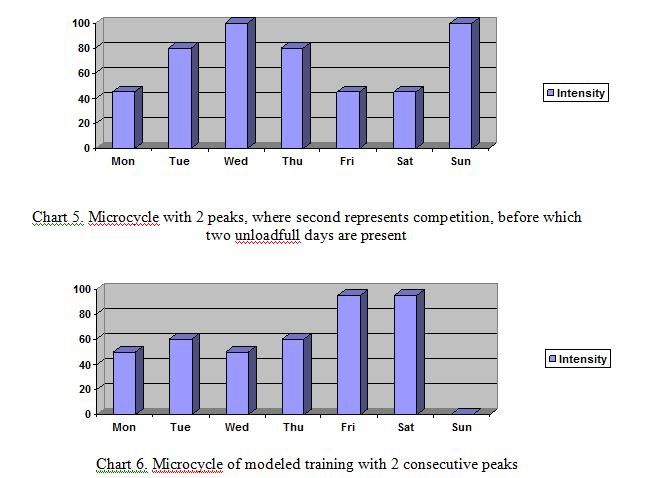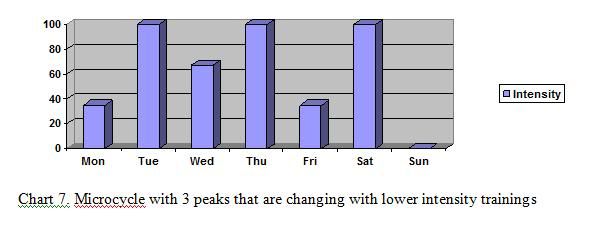Many factors should be taken under look while
creating microcycles, among which are these:
- Set the microcycle goals,
especially for dominant training factors
- Set training goals(training
number, volume, intensity and complexity
- Give the amount of
microcycle intensity – number of maximal intensity trainings and changing
with low intensity trainings
- Mark training and
competition days(if possible)
- Start the microcycle with
the trainings of low or medium intensity and progressively increase the
intensity
- Before important competition
use the microcycle with one day of huge intensity which should be reached
3-5 days before competition
Before each microcycle meeting between coach
and athletes is suggested as good option.
Microcycle classification
Microcycle
dynamics depends on training phase and training factors priority(if body or
technical factors overrule). More important, they have to be reflected on
athletes progress and training capacity. So coach should eliminate
standardization and non-flexibility. Flexibility empowers changes which are
gathered by the coach related to athlete and opponent progress.
It can be structured under the weak number of
trainings. Flexibility is the biggest virtue during periodization programm
creating.
Table 1. 8 trainings example
Mon
|
Tue
|
Wed
|
Thu
|
Fri
|
Sat
|
Sun
|
|
AM
|
X
|
X
|
X
|
X
|
X
|
T
|
T
|
PM
|
T
|
T
|
T
|
T
|
T
|
T
|
X
|
This table shows the plan with eight trainings
where athletes free time is increased during weekends. Letter T is for
training, letter X for rest.
Table 2. Structure 3+1
Mon
|
Tue
|
Wed
|
Thu
|
Fri
|
Sat
|
Sun
|
|
AM
|
T
|
T
|
T
|
T
|
T
|
T
|
X
|
PM
|
T
|
X
|
T
|
X
|
T
|
X
|
X
|
This table shows structure 3+1 where 3 halfes
of the day is reserved for training, where fourth half is free.
Table 3. Structure 5+1
Mon
|
Tue
|
Wed
|
Thu
|
Fri
|
Sat
|
Sun
|
|
AM
|
T
|
T
|
T
|
T
|
T
|
T
|
X
|
PM
|
T
|
T
|
X
|
T
|
T
|
X
|
X
|
This table shows structure 5+1 where 5 halfes
of the day is reserved for training, and one half for rest.
Table 4. Structure 5+1+1
Mon
|
Tue
|
Wed
|
Thu
|
Fri
|
Sat
|
Sun
|
|
AM
|
T
|
T
|
T
|
T
|
T
|
T
|
T
|
PM
|
T
|
T
|
X
|
T
|
T
|
X
|
X
|
This table shows structure 5+1+1 where 5 halfes
of the day are work, one half rest, after that one half work.
Table 5. Microcycle with structure 5+1+1
Mon
|
Tue
|
Wed
|
Thu
|
Fri
|
Sat
|
Sun
|
|
7:00
|
ST
|
ST
|
ST
|
ST
|
ST
|
ST
|
ST
|
17:00
|
T
|
T
|
T
|
T
|
T
|
T
|
X
|
19:00
|
WT
|
WT
|
X
|
WT
|
WT
|
X
|
X
|
This table shows 5+1+1 structure, additional
trainings(ST) come in the early morning, with main training in the evening,
after that goes weight training(WT) in the gym
If
intensity is being increased, rule of progression load should be followed and
number of peak intensities and high demands on training should also be though
about. Altitude, temperature, long journey, climax
can also influent on number of peaks reaching in the program of microcycles
training. First serves for adjustment. In hot, wet climaxes intensity peak
should be planned in the beginning of the day, when athletes still have power.













0 коментара:
Постави коментар